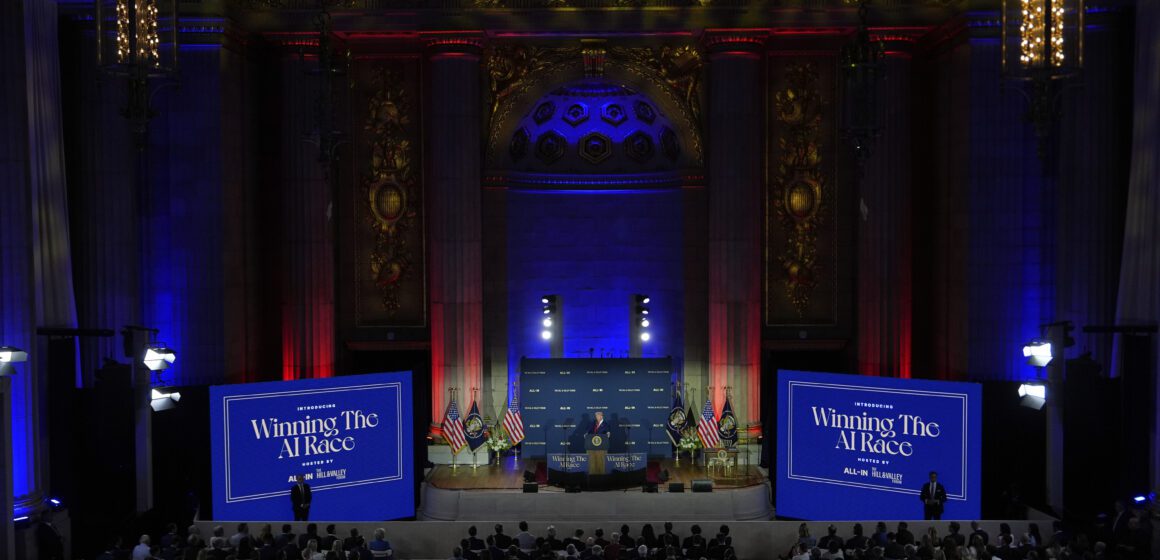President Donald Trump on Wednesday announced a sweeping plan to accelerate the development of artificial intelligence and further integrate the technology across the federal government.
His speech made clear he wanted to allow a lot of leeway for tech executives to lead, and that he sees artificial intelligence as a crucial way for the country to stay competitive in the future.
“We need U.S. technology companies to be all in for America. We want you to put America first,” Trump said at an AI conference, to a crowd of government officials, lawmakers and industry insiders.
“America is the country that started the AI race and as president of the U.S., I’m here today to declare that America is going to win it,” Trump added.
During the event, Trump signed a series of executive orders to incorporate the recommendations in the White House’s action-plan report into official federal policy. The report lays out a pathway to what the White House said would “ensure global dominance in artificial intelligence” for the U.S.
“The industry is a beautiful baby that’s born. We need to grow that baby and let that baby thrive. We can’t stop it with politics, we can’t stop it with foolish rules,” Trump said. “At the same time, we need rules, but they need to be smart, they need to be brilliant.”
The action plan calls for federal agencies to exempt certain AI infrastructure projects from environmental review, to make federal lands available for building AI infrastructure, to export AI technology to allied countries and to push agencies to contract AI that “objectively reflects truth” and “American values.”
Trump’s action plan also provides an ideological framework for AI models that are integrated within government agencies.
The report directs federal agencies to contract only with AI models that are “free from ideological bias” and are “designed to pursue objective truth rather than social engineering agendas.” The report says that AI models contracted by federal agencies should “eliminate references to misinformation, Diversity, Equity, and Inclusion, and climate change.”
These proposals are designed to make sure AI “remains truth seeking and trustworthy,” David Sacks, a senior White House AI adviser, told reporters on a call earlier on Wednesday.
The report, which Sacks said was designed with input from the private sector, also lays out a plan to disincentivize state-level AI regulation, which AI companies have long opposed.
In his speech, Trump also advocated for “one common sense federal standard.”
“We have to have a single federal standard, not 50 different states regulating this industry of the future,” Trump said. “I want you to be successful, but I want you to be successful and you can’t have one state holding you up,” he said about the AI industry.
The report recommends federal agencies with “AI-related discretionary funding” to consider state-level AI regulation before making funding decisions and to “limit funding if the state’s AI regulatory regimes may hinder the effectiveness of that funding or award.”
Several states, including Colorado and California, have passed or are working to pass regulations governing the development and implementation of AI. Congressional Republicans tried to add a national ban on state-level AI regulation in the budget reconciliation bill passed last month. The measure was ultimately taken out of the bill, but proponents, like Sen. Ted Cruz, have said they plan to reintroduce the measure in future legislation.
Michael Kratsios, a White House science and technology adviser, said on Wednesday that government agencies should repeal “unnecessary bureaucratic red tape” that he said slows down the adoption of AI across federal agencies within the next year.
The report recommends federal agencies identify and repeal internal policies that could slow down the adoption, development, integration or deployment of AI. It also advises agencies to find areas of collaboration between the government and private companies while creating conditions where the “private-sector-led innovation can flourish.”
“We’re asking the private sector to recommend regulatory barriers” for the administration to consider removing,” Kratsios added.
During his speech, Trump said he wanted to turn the U.S. into an “AI export powerhouse,” ensuring that allies source AI technology from the U.S.
“Under my administration, we will maintain necessary protections for our national security, but will never forget that the greatest threat of all is to forfeit the race and force our partners into rival technology.”
Kratsios said that exporting American AI technology would ensure market dominance for U.S. developers and disincentivize possible allies to contract Chinese AI technology.
Kratsios said that “American AI must be the gold standard” and the Department of Commerce would establish a program to export U.S.-developed hardware, AI models and standards to allied countries while strengthening export controls on foreign adversaries like China.
“The federal government has a role in making it easier for our allies and partners to do business with American innovators and ensure that the world runs on American AI,” Kratsios said.
Samuel Larreal is a NOTUS reporter and an Allbritton Journalism Institute fellow. This story was produced as part of a partnership between NOTUS and San José Spotlight.



Leave a Reply
You must be logged in to post a comment.